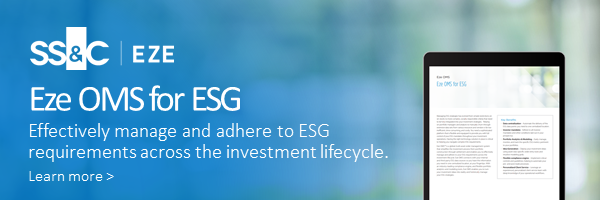As social movements continue to raise awareness of issues like diversity and climate change, the demand for environmental, social, and governance (ESG) integration into investment portfolios is growing. And managing ESG strategies is no longer just about simple restrictions on sin stocks; it’s evolved into more complex, socially responsible criterion ingrained into investment strategies. As a result, many fund managers are finding managing their ESG mandates to be tedious, time-consuming, and human-intensive.
What Challenges Do Fund Managers Face?
The main challenge for fund managers is finding a way to combine an ESG investment directive with ESG data to create an effective program that produces results for investors, but that isn’t overly manual or time-consuming and doesn’t rely exclusively on the discretion of the portfolio manager.
Over 80% of S&P companies provide ESG data for analysis, but there’s no standard reporting framework or set of rules. Bloomberg, FactSet, and MSCI are spinning out ESG scoring data based on different data sources, while some fund managers are utilizing proprietary data of their own. This lack of standardization in the industry makes it difficult for fund managers to integrate the data into their investment ecosystem and monitor their portfolio whilst adhering to their stated objectives, without spending valuable time and resources on it. Other pain points that arise from the lack of industry standards include generating accurate investor reports and navigating complex compliance rules.
It’s important for fund managers to have the right technology to automate and simplify the process to help them improve their management of ESG mandates and ultimately set them apart from their competitors.
What are the Technology Must-Haves for Managing ESG Strategies?
Many of our clients started with the question - how can we create alignment throughout the investment lifecycle with our ESG mandates?
Your technology platform should be flexible and equipped to give you more control over your ESG mandates through every part of the investment process, helping to prevent problems before they happen. Here are just a few of the features you should look for in your platform if you are considering an ESG strategy:
- Data Connectivity: With multiple third-party sources providing ESG scoring data, including Bloomberg, FactSet, MCSI, and Sustainalytics, your system needs to have reliable API connectivity to seamlessly integrate your preferred ESG data across the front-to-back office. Unique custom fields will give you additional flexibility when integrating data into the system. In Eze OMS, we have security-level user-defined fields that can be created in the front-end to denote ESG rating and then leveraged throughout the system.
- Modeling and Analytics: It’s important to holistically view the ESG impact on trades as they’re proposed. You want a platform that allows you to slice-and-dice your portfolio by ESG rating or simulate changes in a portfolio to see how it would impact exposures across ratings.
- Flexible Compliance Engine: Your platform should make it straightforward for you to create rules on your ESG data. Look for a system that has ready-made ESG templates that you can update to meet your specific needs. Additionally, you’ll want an easy-to-use rule builder to create your own custom rules based on ESG criteria, specific to the portfolio, fund, or account. You should be able to proactively monitor data in real-time and be notified of critical data changes and rule violations as they happen. For instance, in Eze OMS, users can identify, research, and action compliance breaches directly from a single screen as they happen.
Here in the EMEA region, we’re seeing ESG factors play a big role in the investment strategies of funds in the Nordics and the Netherlands in particular, but it’s a trend that’s growing globally. We expect to see the focus on ESG investing continue to grow beyond the COVID-19 pandemic. Fund managers who are not currently employing ESG strategies may want to consider if and how their technology is equipped to handle ESG-focused operations. Managers who are employing ESG strategies are likely to see increased interest in this type of investing in the coming years and may want to take this time to reevaluate the technology they currently operate on to ensure it is as effective and efficient as possible.
If you’re looking to incorporate ESG factors into your investment criteria, learn the considerations you should make when implementing ESG strategies, or check out Eze OMS for ESG:
.jpg?width=575&name=Mobile%20phone%20hands%20(1).jpg)

